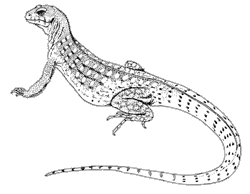Desert Iguana
(Dipsosaurus dorsalis)
Order: Squamata
Family: Iguanidae (iguanid lizards)
Spanish names: porohui, lagartijo
Distinguishing Features
This medium-sized lizard with a blunt head and long tail reaches a length of 16 inches (40 cm), including the tail. It is pale gray or whitish with a tan or brown reticulated pattern on the back and sides. Down the center of the back is a row of slightly enlarged, keeled scales. Rows of brown spots are on the tail, which is as long as the body from snout to vent. The belly is pale. During the breeding season, in both sexes, the sides become pinkish.
Range

This heat-loving, desert dweller occurs in southeastern California, southern Nevada, southwestern Utah, and western and south-central Arizona in the United States. The Mexican distribution includes eastern and southern Baja California, northwestern Mexico, and some of the Gulf of California islands. The range of the desert iguana is largely contained within the range of the creosote bush.
Habitat
This lizard is most common in dry, sandy areas dominated by creosote bush. It can also be found in rocky streambeds up to 4000 feet (1200 m). In the southern portion of its range this lizard lives in arid subtropical scrub and tropical deciduous forest associations.
Life History
Desert iguanas emerge from hibernation in mid-March. Breeding occurs in April and May with 2 to 10 eggs laid from late May to early July. Hatchlings emerge late July through August. Desert iguanas may lay 2 clutches of eggs a year under the right conditions. This lizard is extremely tolerant of high temperatures and can be seen active during mid-day even in the hottest summers. Primarily herbivorous, the desert iguana crawls into the branches of creosote bushes and other shrubs to feed upon the leaves and flowers. Additionally, it eats insects, carrion, and fecal pellets of its own species, which aids in the digestion of plant cellulose by establishing the proper gut fauna.
Studies have shown that secretions from the femoral pores (on the underside of the thighs of the rear legs) fluoresce and that the lizard has vision in these wavelengths. So, besides using these secretions as scent markings, they may also serve as visual indicators of a desert iguanaís presence.
Though desert iguanas seem to prefer open, relatively flat habitat, they rely heavily on the creosote bush in these areas for a number of needs. This plant provides some of the lizardís diet (flowers), and the lizard burrows around and under the plantís roots to avoid thermal extremes and predation.










